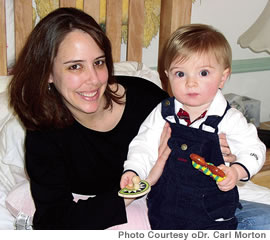
Where Babies Are Made
August 15, 2007
By Carl Morton

Dr. Morton’s daughter Goldie Hancock and her son Quinn

|
How many babies have been born with the help of your institute?
Over 2,000.
Do people send you their baby photos?
Oh, yes, we have a lot of photos.
When people first come to you are they feeling frustrated about their inability to conceive?
Yes, for a lot of patients this is the end of the line for them. They’ve been through many other procedures before they get to in-vitro fertilization.
{embed=“elements/box_ad”}
At what point do couples seek your help?
The general rule is, if the couple is not pregnant in six months to a year they should investigate. If the women is under 35, we allow them to try for a year; if she’s 35 or older we allow them to try for six months (before seeking consultation).
How many times on average do people have to try in-vitro fertilization before they are successful?
If someone tries three times and doesn’t become pregnant, then the chances of success go down a little bit.
And what determines success?
It’s age dependent for the female - under age 36, the chances of success run about 50 percent; at age 40, the chances are 20 percent. At age 43 it’s less than 5 percent because the ideal time to be pregnant is between ages 21 and 33.
What’s the age of the oldest woman who’s gotten pregnant with the help of your clinic?
The oldest using her own eggs is 44. However, if a woman is under 50 years, we would normally recommend donor-egg IVF. After 50, we decline to treat her.
Why?
In my mind the question is whether it’s ethical because if someone is over 50 she’s going to be 65 or older when the child is 15 and going through the throes of adolescence. So 50 is our cutoff for women; there is no age cutoff for men.
The world’s first test-tube baby was England’s Louise Brown, who was born in 1978. When was your clinic’s first success story?
In December of 1985 a baby was born. Her name is Jacqui Low, and she’s 21 years old.
Your clinic started in March 1985 and in December of that year your first baby was born?
And we may still hold the record for the shortest interval between the inception of a program and the birth of a child.
How has your field advanced since then?
One advancement is called PGD, or pre-implantation genetic diagnosis. It’s now possible to biopsy an embryo at the eight-cell stage - that’s three days after the egg is fertilized, but before it’s put into the uterus. ... We can find out whether that embryo has normal chromosomes, and whether it’s a boy or a girl. So if there’s a family history of genetic abnormalities like Down syndrome we can make sure the embryo we put in the uterus is normal.
Can you share some success stories?
My daughter Goldie is married and lives in Maryland. She went to an in-vitro fertilization group in Maryland and failed twice, so I had her come to Honolulu. We did in-vitro fertilization for her here, and she had my first grandchild, a boy named Quinn.
Can you describe in condensed form the process of getting pregnant this way?
It involves physical exam and review of records, measurements of uterus and ovaries, hormone tests, fertility-drug injection lessons, monitoring the ovaries and estrogen level, egg retrieval in the operating room, fertilizing the eggs in the laboratory, embryo transfer three days later, and blood tests and ultrasound to confirm the pregnancy.
{embed=“elements/google_ad336x280”}
Why do you like your job?
There is a lot of satisfaction when a couple achieves a pregnancy with my help. And I like delivering babies. I have delivered about 7,000 in my career. I delivered my first baby when I was a med student in June 1964 so it’s been 43 years that I’ve been delivering babies - and I’m still thrilled.
You have a free seminar coming up?
Saturday, Aug. 18, 12 noon sharp, in the second-floor auditorium at Kapiolani Medical Center (at the corner of Punahou and Bingham streets). There’s validated parking, and people can call 946-2226 to sign up, but there is plenty of room if they just want to show up.